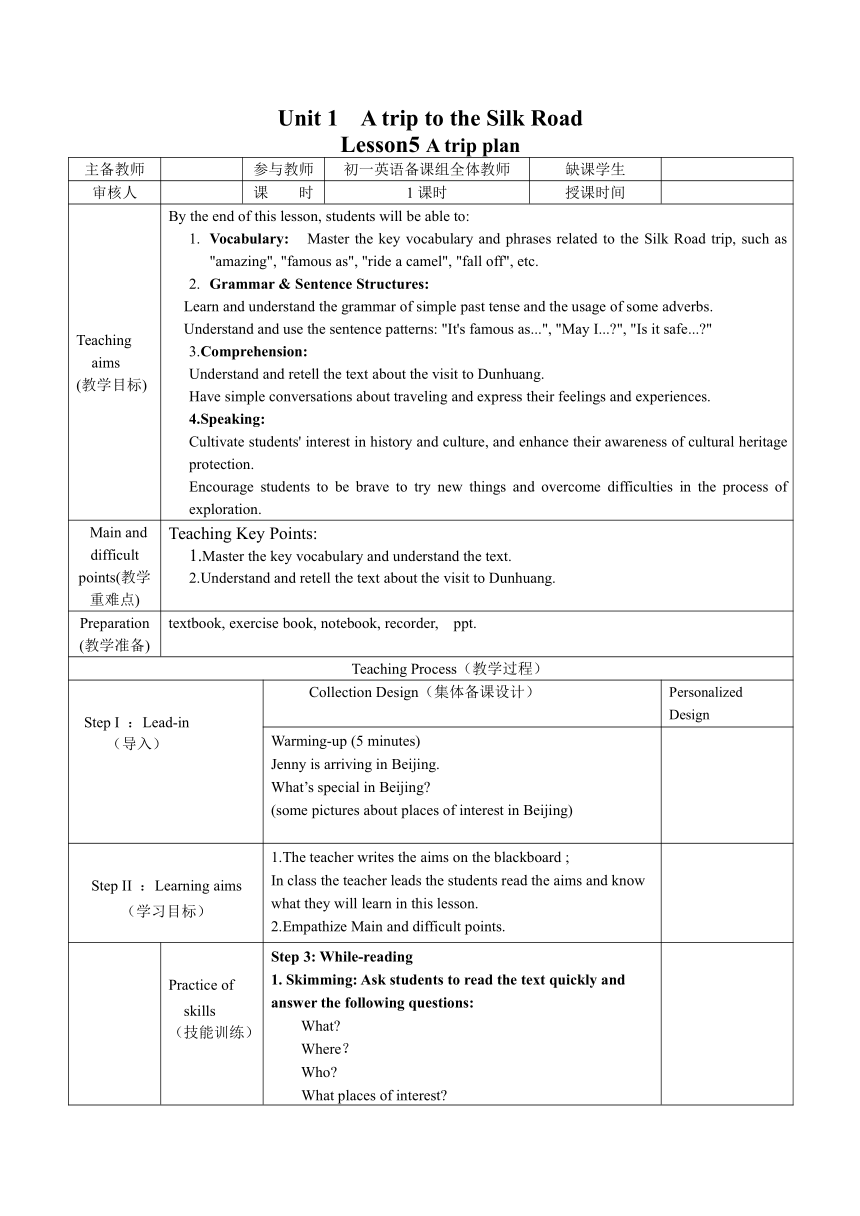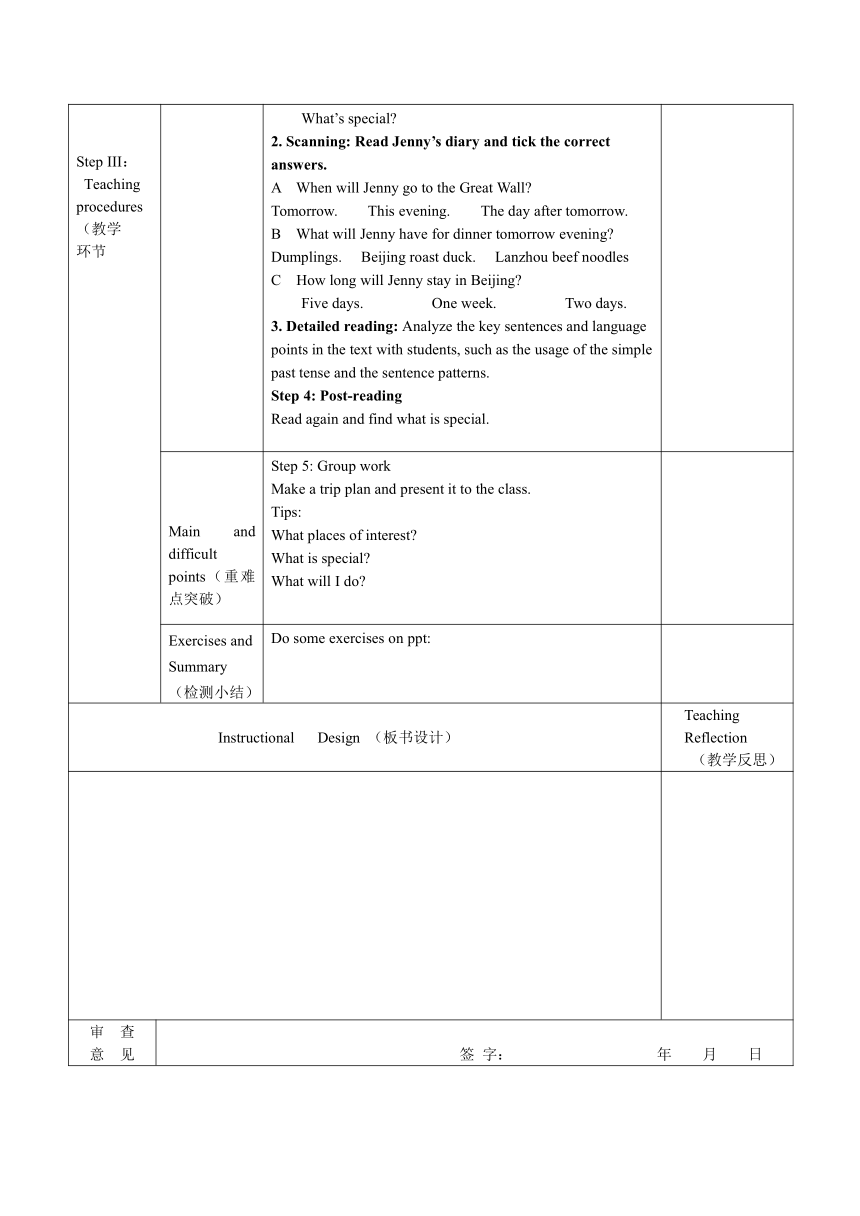Unit 1 Lesson5~6教学设计(表格式)冀教版(2024)七年级下册
文档属性
| 名称 | Unit 1 Lesson5~6教学设计(表格式)冀教版(2024)七年级下册 |  | |
| 格式 | docx | ||
| 文件大小 | 27.9KB | ||
| 资源类型 | 教案 | ||
| 版本资源 | 冀教版 | ||
| 科目 | 英语 | ||
| 更新时间 | 2025-02-24 12:06:44 | ||
图片预览


文档简介
Unit 1 A trip to the Silk Road
Lesson5 A trip plan
主备教师 参与教师 初一英语备课组全体教师 缺课学生
审核人 课 时 1课时 授课时间
Teaching aims (教学目标) By the end of this lesson, students will be able to: Vocabulary: Master the key vocabulary and phrases related to the Silk Road trip, such as "amazing", "famous as", "ride a camel", "fall off", etc. Grammar & Sentence Structures: Learn and understand the grammar of simple past tense and the usage of some adverbs. Understand and use the sentence patterns: "It's famous as...", "May I... ", "Is it safe... " 3.Comprehension: Understand and retell the text about the visit to Dunhuang. Have simple conversations about traveling and express their feelings and experiences. 4.Speaking: Cultivate students' interest in history and culture, and enhance their awareness of cultural heritage protection. Encourage students to be brave to try new things and overcome difficulties in the process of exploration.
Main and difficult points(教学重难点) Teaching Key Points: 1.Master the key vocabulary and understand the text. 2.Understand and retell the text about the visit to Dunhuang.
Preparation (教学准备) textbook, exercise book, notebook, recorder, ppt.
Teaching Process(教学过程)
Step I :Lead-in (导入) Collection Design(集体备课设计) Personalized Design
Warming-up (5 minutes) Jenny is arriving in Beijing. What’s special in Beijing (some pictures about places of interest in Beijing)
Step II :Learning aims (学习目标) 1.The teacher writes the aims on the blackboard ; In class the teacher leads the students read the aims and know what they will learn in this lesson. 2.Empathize Main and difficult points.
Step III: Teaching procedures (教学 环节 Practice of skills (技能训练) Step 3: While-reading 1. Skimming: Ask students to read the text quickly and answer the following questions: What Where? Who What places of interest What’s special 2. Scanning: Read Jenny’s diary and tick the correct answers. A When will Jenny go to the Great Wall Tomorrow. This evening. The day after tomorrow. B What will Jenny have for dinner tomorrow evening Dumplings. Beijing roast duck. Lanzhou beef noodles C How long will Jenny stay in Beijing Five days. One week. Two days. 3. Detailed reading: Analyze the key sentences and language points in the text with students, such as the usage of the simple past tense and the sentence patterns. Step 4: Post-reading Read again and find what is special.
Main and difficult points(重难点突破) Step 5: Group work Make a trip plan and present it to the class. Tips: What places of interest What is special What will I do
Exercises and Summary (检测小结) Do some exercises on ppt:
Instructional Design (板书设计) Teaching Reflection (教学反思)
审 查 意 见 签 字: 年 月 日
Unit 1 A trip to the Silk Road
Marco Polo and the Silk Road
主备教师 席尚瑞 参与教师 初一英语备课全体教师 缺课学生
审核人 张 莉 课 时 1课时 授课时间
Teaching aims(教学目标) By the end of this lesson, students will be able to: Master the key vocabulary:Silk Road, coal, discover, goods, journey… Understand the text and Describe the journey of Marco Polo with the past tense. Encourage curiosity about Chinese culture and history and enhance their awareness of cultural heritage protection. Encourage students to be brave to try new things and overcome difficulties in the process of exploration.
Main and difficult points(教学重难点) 1.Master the key vocabulary and main sentences. 2.Understand the text and describe the journey of Marco Polo with the past tense.
Preparation (教学准备) textbook, exercise book, notebook, recorder.
Teaching Process(教学过程)
Step I :Lead-in (导入) Collection Design(集体备课设计) Personalized Design (个性化设计)
What do you know about Marco Polo and the Silk Road Introduce the Travels of Marco Polo and the Silk Road and Marco Polo
Step II :Learning aims (学习目标) The teacher writes the aims on the blackboard; In class the teacher leads the students read the aims and know what they will learn in this lesson. Empathize Main and difficult points. The students must read the learning aims together and make sure to know what to study .
Step III: Teaching procedures (教学 环节) Presentation (展示 呈现) Marco Polo (1254—1324), a Venetian trader and explorer who was famous for his worldwide travels. His famous book is The Description of the World, also known as The Travels of Marco Polo, a book that described to Europeans the wealth and great size of China, its capital Peking, and other Asian cities and countries.
Practice of skills (技能训练) Step1: Read the passage and tick the correct pictures. How did Marco Polo’s family move goods along the Silk Road Step2:Read the passage again and answer the questions. A When did Marco Polo come to China B What did Marco Polo bring back to Italy from China C What’s the name of the book about Marco Polo’s trip to China Step3:Here is a brief description of China in The Travel of Marco Polo. Guess what the word in bold is. Step4: Learn about Zhang Qian's Road Map to the Western Regions
Main and difficult points(重难点突破) 1. At the age of 17, he began to travel along the Silk Road with his father and uncle. 在17岁的时候,他开始和他的父亲,叔叔沿着丝绸之路旅行。 at the age of.....在.....岁时=at one’s age of.... at his age of 2. Marco Polo arrived in Beijing. 马克·波罗到达北京。 begin 开始=start begin/start to do sth.开始做某事 e.g. He begins/starts to learn English at the age of six. 他六岁的时候开始学英语
Exercises and Summary (检测小结) Do the exercises on ppt
Instructional Design (板书设计) Teaching Reflection (教学反思)
审 查 意 见 签 字: 年 月 日
Lesson5 A trip plan
主备教师 参与教师 初一英语备课组全体教师 缺课学生
审核人 课 时 1课时 授课时间
Teaching aims (教学目标) By the end of this lesson, students will be able to: Vocabulary: Master the key vocabulary and phrases related to the Silk Road trip, such as "amazing", "famous as", "ride a camel", "fall off", etc. Grammar & Sentence Structures: Learn and understand the grammar of simple past tense and the usage of some adverbs. Understand and use the sentence patterns: "It's famous as...", "May I... ", "Is it safe... " 3.Comprehension: Understand and retell the text about the visit to Dunhuang. Have simple conversations about traveling and express their feelings and experiences. 4.Speaking: Cultivate students' interest in history and culture, and enhance their awareness of cultural heritage protection. Encourage students to be brave to try new things and overcome difficulties in the process of exploration.
Main and difficult points(教学重难点) Teaching Key Points: 1.Master the key vocabulary and understand the text. 2.Understand and retell the text about the visit to Dunhuang.
Preparation (教学准备) textbook, exercise book, notebook, recorder, ppt.
Teaching Process(教学过程)
Step I :Lead-in (导入) Collection Design(集体备课设计) Personalized Design
Warming-up (5 minutes) Jenny is arriving in Beijing. What’s special in Beijing (some pictures about places of interest in Beijing)
Step II :Learning aims (学习目标) 1.The teacher writes the aims on the blackboard ; In class the teacher leads the students read the aims and know what they will learn in this lesson. 2.Empathize Main and difficult points.
Step III: Teaching procedures (教学 环节 Practice of skills (技能训练) Step 3: While-reading 1. Skimming: Ask students to read the text quickly and answer the following questions: What Where? Who What places of interest What’s special 2. Scanning: Read Jenny’s diary and tick the correct answers. A When will Jenny go to the Great Wall Tomorrow. This evening. The day after tomorrow. B What will Jenny have for dinner tomorrow evening Dumplings. Beijing roast duck. Lanzhou beef noodles C How long will Jenny stay in Beijing Five days. One week. Two days. 3. Detailed reading: Analyze the key sentences and language points in the text with students, such as the usage of the simple past tense and the sentence patterns. Step 4: Post-reading Read again and find what is special.
Main and difficult points(重难点突破) Step 5: Group work Make a trip plan and present it to the class. Tips: What places of interest What is special What will I do
Exercises and Summary (检测小结) Do some exercises on ppt:
Instructional Design (板书设计) Teaching Reflection (教学反思)
审 查 意 见 签 字: 年 月 日
Unit 1 A trip to the Silk Road
Marco Polo and the Silk Road
主备教师 席尚瑞 参与教师 初一英语备课全体教师 缺课学生
审核人 张 莉 课 时 1课时 授课时间
Teaching aims(教学目标) By the end of this lesson, students will be able to: Master the key vocabulary:Silk Road, coal, discover, goods, journey… Understand the text and Describe the journey of Marco Polo with the past tense. Encourage curiosity about Chinese culture and history and enhance their awareness of cultural heritage protection. Encourage students to be brave to try new things and overcome difficulties in the process of exploration.
Main and difficult points(教学重难点) 1.Master the key vocabulary and main sentences. 2.Understand the text and describe the journey of Marco Polo with the past tense.
Preparation (教学准备) textbook, exercise book, notebook, recorder.
Teaching Process(教学过程)
Step I :Lead-in (导入) Collection Design(集体备课设计) Personalized Design (个性化设计)
What do you know about Marco Polo and the Silk Road Introduce the Travels of Marco Polo and the Silk Road and Marco Polo
Step II :Learning aims (学习目标) The teacher writes the aims on the blackboard; In class the teacher leads the students read the aims and know what they will learn in this lesson. Empathize Main and difficult points. The students must read the learning aims together and make sure to know what to study .
Step III: Teaching procedures (教学 环节) Presentation (展示 呈现) Marco Polo (1254—1324), a Venetian trader and explorer who was famous for his worldwide travels. His famous book is The Description of the World, also known as The Travels of Marco Polo, a book that described to Europeans the wealth and great size of China, its capital Peking, and other Asian cities and countries.
Practice of skills (技能训练) Step1: Read the passage and tick the correct pictures. How did Marco Polo’s family move goods along the Silk Road Step2:Read the passage again and answer the questions. A When did Marco Polo come to China B What did Marco Polo bring back to Italy from China C What’s the name of the book about Marco Polo’s trip to China Step3:Here is a brief description of China in The Travel of Marco Polo. Guess what the word in bold is. Step4: Learn about Zhang Qian's Road Map to the Western Regions
Main and difficult points(重难点突破) 1. At the age of 17, he began to travel along the Silk Road with his father and uncle. 在17岁的时候,他开始和他的父亲,叔叔沿着丝绸之路旅行。 at the age of.....在.....岁时=at one’s age of.... at his age of 2. Marco Polo arrived in Beijing. 马克·波罗到达北京。 begin 开始=start begin/start to do sth.开始做某事 e.g. He begins/starts to learn English at the age of six. 他六岁的时候开始学英语
Exercises and Summary (检测小结) Do the exercises on ppt
Instructional Design (板书设计) Teaching Reflection (教学反思)
审 查 意 见 签 字: 年 月 日
同课章节目录
